#ayizan
Explore tagged Tumblr posts
Text
Exciting news! 🎶🚨
AYIZAN has just dropped their album "TRANSPARANS" on all music streaming services! Checkout the captivating tunes of this CD today. 🌟
#haiti legends#ayizan#ayizan transparans#transparans#ayizanmusicproductions#ayizan haitian band#haitianbands#tit pascal#alix pascal#felix Etienne#pierre cine#Morgan Zwerlein#new music#new music monday#out now#rasin#world music#global#haitilegends#iamgabrisan
3 notes
·
View notes
Text


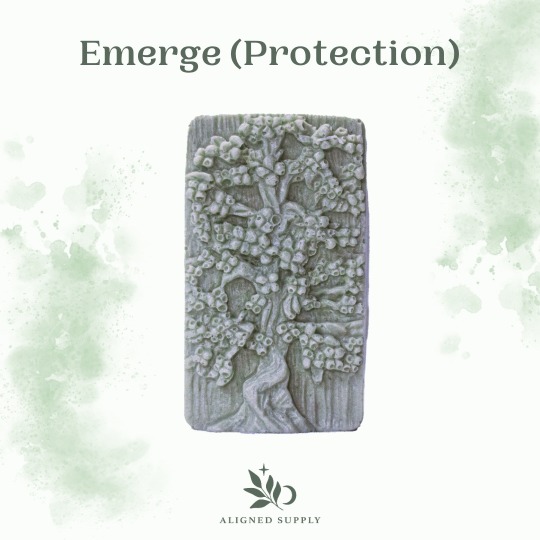






It’s time for Spring Cleaning and Renewal at Aligned Supply! 🪴🌷🦋🧹🪺🥚🧽🐣����🪻
✨Spirits Featured✨
Danbala Wèdo
Ayida Wèdo
Papa Loko
Manbo Ayizan
Klemezin, Lovana, Madan Letan
Obatala
Orishanla
🪴Herbal Features🪴
🌿Rue/Fèy Wou
🌿Eucalyptus/Fèy Kaliptis
🌿Moringa/Fèy Benzoliv
🌿Basil/Fèy Basilik
🌿Hyssop/Fleur Izòp
🌿Soursop leaf/Fèy Kowosol
🌿Olive leaf/Fèy Oliv
💎Crystal features💎
💚Green aventurine
🤍Selenite
💚Peridot
🤍Clear quartz
🖤Shungite
#alignedsupply#spirit series#herbal soap#crystal soap#spring equinox#Danbala#damballah#Ayida#Loko#ayizan#Klemezin#lovana#madan letan#Obatala#Orishanla#rue#Basil#hyssop#moringa#soursop#olive oil#coconut oil#eucalyptus#peridot#selenite#clear quartz#shungite
0 notes
Text
AYIZAN // VODOU LOA OF THE MARKETPLACE & COMMERCE
“She is the loa of the marketplace and commerce in Vodou, especially in Benin, Haiti and Suriname. She is a racine, or root loa, associated with Vodoun rites of initiation (called kanzo). Ayizan is regarded as the first, or archetypal, mambo (priestess), and as such is also associated with priestly knowledge and mysteries, particularly those of initiation and the natural world. She is syncretized with the Catholic Saint Clare. Her symbol is the palm frond, and she drinks no alcohol. Her colors are most commonly silver, blue, and white.”
0 notes
Text
Queen of the Marketplace and a spirit of initiation. She is the lwa of primordial ancestors and the repository of mystic spiritual secrets. Ayizan is the spirit of the very first Vodou priestess (Mambo or Manbo). She is among the most primordial of spirits and must be treated with extreme respect. Address her politely as Mambo Ayizan. Should one be making offerings to a number of spirits, Ayizan must be among the first honored, if not the very first.
Ayizan’s name may mean “sacred earth.” In the Fon language of Dahomey, from whence she derives, Aïzan refers to earthen mounds heaped up in the marketplace intended to honor primal ancestors. Azan, a related word, refers to fringes of palm fronds used to demarcate sacred space.
Ayizan is old, truly among the elder spirits; she can’t be bothered with small, trivial problems. She oversees the initiation process of hounsi (Vodou priestesses). She is also the matron of women who work in the marketplace and assures their success.
Ayizan protects against the Evil Eye, malice, envy, and jealousy. She despises and punishes exploiters: rich against poor; powerful against the weak; adults against children; men against women; husbands against wives. If you perceive yourself as oppressed and exploited, she may assist you. (Don’t bother her if you’re on the wrongend of this equation.) Request that Ayizan protect you and supervise your spiritual growth.
She has an incredible knowledge and command of the spirit world. Ayizan may be petitioned to reveal information or serve as an intercessor (if she chooses). Ayizan banishes malevolent entities and exorcises them. She can cleanse and purify an area and create sacred space. She protects entrances, doors, gateways, barriers, markets, and public spaces. In her book, Vodou Visions, author and manbo Sallie Ann Glassman compares Ayizan to the Gnostic Sophia exiled in the material world: the initiatrix in the marketplace.
She appears in natural phenomenon: palms and earth mounds but also as an elderly woman.
Ayizan is represented by a palm branch or earthen mounds, anointed with oil and surrounded by palm fronds. Images of Saint Anne, to whom she is syncretized, or Christ being baptized by John the Baptist (his initiation) also represent her.
As Queen of the Marketplace, Ayizan is Mrs. Legba. As Grand Initiatrix, her work husband so to speak, her mate is Papa Loko.
Women who seek Ayizan’s protection for home or store should obtain blessed palms (whether on Palm Sunday or via other rituals). Fix them into the shape of an X or cross and hang over your door while invoking Ayizan’s blessings.
TREE:
Palm
COLOURS:
White, silver
METAL:
Silver (traditionally the incorruptible metal)
OFFERINGS:
White flowers, bananas, plantains, yams, hearts of palms; dirt from an outdoor market crossroads; spring water and sweet liqueurs
1 note
·
View note
Text



Unlike Qaletaqa, Ayizan is not naturally suspicious of people. Therefore, she thought to just ask how they got the cowplant in the first place. Yet, Father Seraiah's prickly demeanour let the witch know that she'd get nowhere fast with the inquiries.
KINE: week six
#ayizan brokejaw#father seraiah kine#kine(6)#kine.exe#c://hilago.exe#hilago(6)#ts2#ts2 historical#ts2 gameplay
9 notes
·
View notes
Text
Manbo Ayizan is the loa of marketplace, commerce, initiations, and spiritual wisdom.
Veneration ritual to bring forth prosperity and abundance into the house.




#witch community#witch#witchcore#witchcraft#african spirituality#african#haitian vodou#vodounritual#vodou#vodoun#voodoo
19 notes
·
View notes
Text
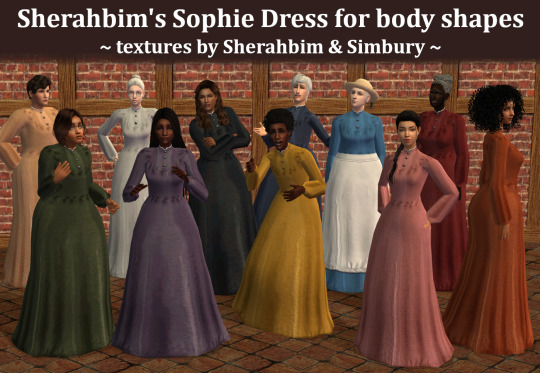
Download all: SFS / Mega
This dress caught my eye when I saw it on @nervosims's Ayizan ❤️ It's originally on an AF mesh from All About Style, retextured by Sherahbim here and beautifully recolored by @simbury here.
I fixed and edited some things on the AF mesh, then converted it for: • Maxis-size TU, AM, EU • Melodie9 fat TU, AU, EU • Momma Lisa AF-EF
Everyone has a fat morph, adults and teens have preg morphs. The recolors are categorized as everyday, formal and outerwear. Custom body shapes are BSOK'd.
Previews and details under the cut.
The swatch
All body shapes get the same recolors. For AF I'm only providing my edited mesh: you need to get the AF recolors from Sherahbim and Simbury. All other recolors can be either standalone or repo'd to AF.

~
The meshes
All F meshes are 2,088 poly. All M meshes are 1,904 poly (I did a chest transplant rather than just squish the boobs).
AF ↓

Most notable edits compared to the original AAS mesh are I fixed the wonky wrists + removed a thingy on the back that I'm pretty sure is supposed to be a tag but it would only work with textures that offer some back cleavage + reduced the bust & fleshed out the back to better match the standard Maxis shape.
TF ↓
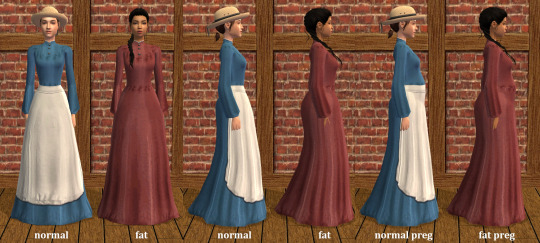
EF ↓
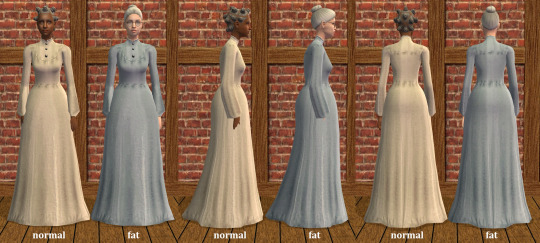
AM ↓
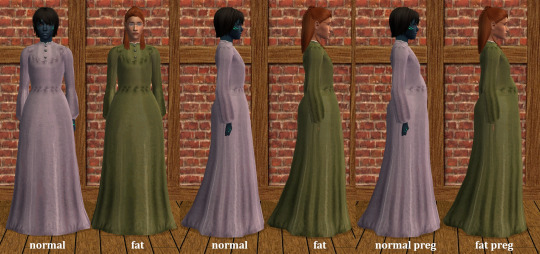
TM ↓
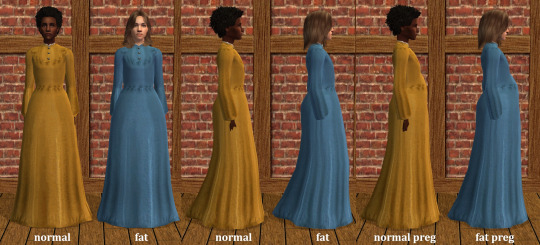
EM ↓
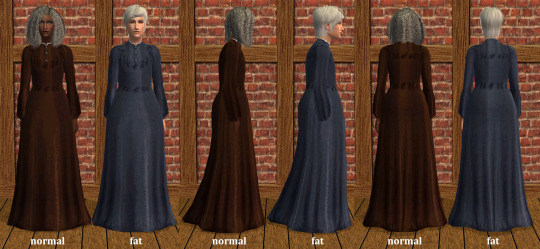
Melodie9 fat AF (afFat) ↓
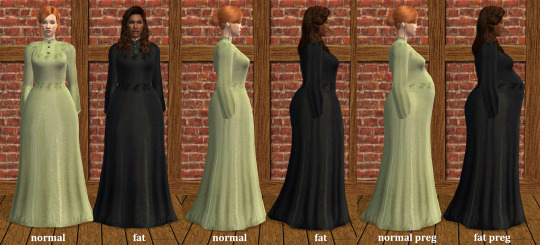
Melodie9 fat TF (tfFat) ↓
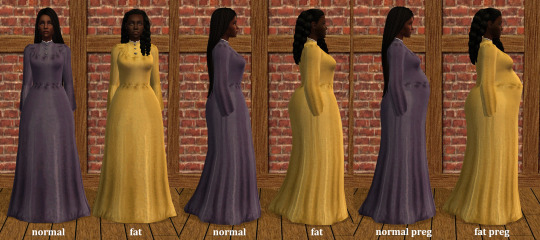
Melodie9 fat EF (efFat) ↓
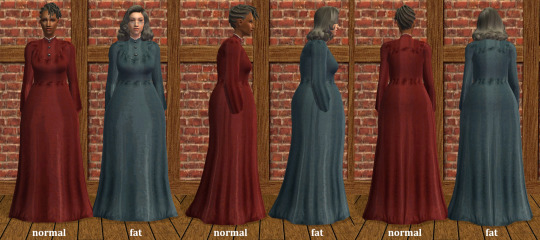
Melodie9 fat AM-EM (aemFat) ↓
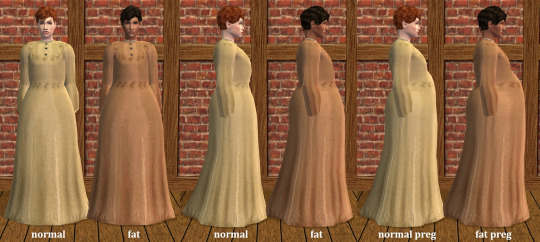
Melodie9 fat TM (tmFat) ↓
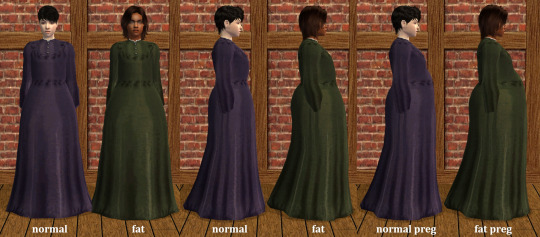
Momma Lisa AF-EF (aefML) ↓
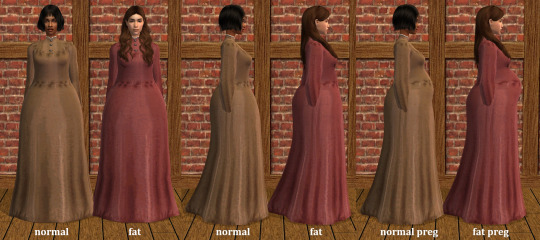
~
Btw I added 2 new tags that you can find all posts for through my downloads page: ❧ one for merfolk ❧ one for historical/fantasy-themed clothing
And I think I'm gonna discontinue #teenpreg because all the teen clothes I make have preg morphs anyway now.
#sims 2#download#body shapes#clothing:everyday#clothing:formal#clothing:outerwear#momma lisa#fat family#sims 2 cc#sims 2 download#ts2cc#s2cc#s2cc historical fantasy#melodie9 fat ef#melodie9 fat af#melodie9 fat tf#melodie9 fat female#melodie9 fat male#melodie9 fat aem#melodie9 fat tm
89 notes
·
View notes
Text
RE: Was Baron Samedi worshiped in New Orleans prior to the late 20th century?
This one is also about the actual lwa.
Baron Samedi can aptly be described as not just the most iconic lwa, but one of the most iconic things from New Orleans Voodoo. Ironically, I have only found inconclusive evidence that he was worshiped in New Orleans during the 19th or early 20th centuries.
In American popular media, Baron Samedi is frequently conflated with other Haitian deities, called the Gede. The real-life Baron Samedi has his origins in Haitian Vodou, as does Maman Brigitte (Gran Brijit). The Haitian lwa are derived from African deities, among the most important being the Dahomean trickster god Legba (himself, derived from the Yoruba deity Eshu). Over the course of Haitian history, Dahomean Legba was refracted into Papa Legba, Met Kalfou, and the Gede - by extension, the Bawons, including Baron Samedi. This explains why the Gede are trickster deities of sexuality and liminality, who embrace all that is taboo - just like Dahomean Legba!
19th Century New Orleans Voodoo was greatly influenced by Haitian Vodou, due to the massive influx of Haitian refugees that arrived in the Crescent City after the Haitian Revolution. Following the post-Revolution migration wave, several Haitian lwa became features of New Orleans Voodoo, including:
Papa Legba → “Papa Limba” or “La Bas”, syncretized with St. Peter
Damballah → “Daniel Blanc”, syncretized with St. Michael
Agassu → “Yon Sue”, syncretized with St. Anthony
Ogou Feray could have also been worshiped as “Joe Ferraille” (“Joe Feray”), and Ayizan Velekete as “Vériquité”. While the Erzulies were not directly worshiped per se, veneration of Mother Mary was a key feature of 19th century New Orleans Voodoo. (The Erzulies are syncretized with Mother Mary.)
(I should also note that, in New Orleans, the lwa were called “spirits”, while Bon Dieu/Bondye was simply called “God”)
During the 19th century, the two most important lwa were probably Papa Legba - the Doorkeeper - and Damballah - the most ancient of the lwa. This would explain why their names appear most frequently in 19th- and 20th-century sources, especially in large scale rituals. Damballah might have been refracted into multiple deities, including “Daniel Blanc” and “Zombi the Snake God” – a deity famously associated with Marie Laveau. Others argue that “Grand Zombi” is actually derived from the Kongo supreme deity Nzambi Mpungu, or an invention fabricated by journalists.
A third key deity – “Onzancaire” / “Monsieur Assonquer” – might have been associated with Ogou Feray – one of the most important Haitian lwa. However, the origins of “Onzancaire” are elusive. Because so many different theories have been proposed, I do not know where his true origins lie.
Other deities of non-Haitian origin were also features of New Orleans Voodoo. St. Marron (Jean St. Malo) was the New Orleanian folk saint of runaway slaves. Mother Leafy Anderson – founder of the Spiritual Church Movement in New Orleans – introduced worship of the Native American Saint Black Hawk (see: Kodi A. Roberts (2015) Voodoo and Power: The Politics of Religion in New Orleans, 1881–1940). My understanding is that “Dr. John” (Jean Montaigne) was also deified, in a similar manner to St. Black Hawk. Orisha, such as Shango and Oya, may too have been worshiped. Other deities are listed here and here.
Baron Samedi is conspicuously absent. I think this has to do with the history of Haitian Vodou. Prior to the Haitian Revolution, Haitian Vodou was less of an organized religion, described as a "widely-scattered series of local cults" (see: The Social History of Haitian Vodou, p. 134). It was between the years 1804 and 1860 that Haitian Vodou began to stabilize into a clear predecessor of its present form. (see: The Social History of Haitian Vodou, p. 139) This period of stabilization took place after the migration wave of the early 19th century, which could explain why key features of Haitian Vodou are missing from 19th century New Orleans. For example, I have yet to find evidence that division of the Petwo and Rada lwa made it over to American soil. The refraction of Dahomean Legba might have never been transmitted by Haitian refugees, which would explain the absence of Met Kalfou and the Gede/Bawons from worship.
This too explains why the Papa Legba of American history was both Doorkeeper AND Guardian of the Crossroads. It has been theorized that the legendary “Devil at the Crossroads” was actually Met Kalfou. However, this “Devil” does not match the appearance of Kalfou, described as "no ancient, feeble man...huge and straight and vigorous, a man in the prime of his life." Instead, the one at “the Crossroads” appears as a limping old man who loves music and dogs (“Hellhound on my Trail”). It’s Papa Legba!
Rather than Kalfou, I think American Papa Legba actually inherits his more menacing attributes from Eshu. This would explain why he walks with a limp (like Eshu), is notoriously vengeful (like Eshu), and is sometimes described as androgynous (like Eshu!).
In any case, the Papa Legba of American history can be clearly traced back to Haiti. His appearance as a limping old man is inherited from Haitian Papa Legba; his love of dogs and music from Dahomean Legba. 19th century sources clearly identify him with Saint Peter (“St. Peter, St. Peter, open the door;”) The same cannot be said for Baron Samedi. He was probably not syncretized with St. Expedite, because St. Expedite “did not achieve popularity until the late 1800s or early 1900s in New Orleans” – long after the Haitian migration wave.
I have found one compelling source that places worship of Baron Samedi in 19th century New Orleans. Creole author Denise Alvarado is something of an expert on this topic, her being born and raised in New Orleans. In Witch Queens, Voodoo Spirits, and Hoodoo Saints: A Guide to Magical New Orleans (2022), Denise Alvarado identifies a “Spirit of Death” with Baron Samedi / Papa Gede. The most convincing piece of evidence comes from the second interview, in which the interviewee describes a ceremony where attendees donned purple robes. The color purple has been historically associated with Papa Gede (by extension, Baron Samedi).
That being said, I do think the evidence Alvarado provides is tenuous. Without additional context, it’s difficult to say whether the purple robes are truly linked to the Haitian lwa. The other newspaper article sounds rather sensationalized. The 19th century saw horrendous news coverage of New Orleans Voodoo, where reporters would exaggerate or straight-up fabricate details to demonize Vodouisants. The reporter’s description of the spirits of death does not align with the Haitian Gede or Bawons. It is important to remember that New Orleans Voodoo is not entirely Haitian in origin. Several other traditional African spiritualities are woven into New Orleans Voodoo. Prior to the Haitian migration wave of the early 19th century, one of the main influences was Kongo spirituality, in which ancestor veneration is central. Additionally, the newspaper cited is from the year 1890 – years after Marie Laveau’s death. The reliability of this article is therefore questionable. I think this could be a Damballah / “Grand Zombi” situation, where this “Spirit of Death” bears superficial resemblance to the lwa but isn’t actually him. It is also possible that he is simply a fabrication by journalists.
The defamation of Vodou continued into the early 20th century, as Haiti was occupied by the U.S. between the years 1915 and 1934. I don’t see how worship of the Gede/Bawons could have been transmitted to New Orleans between the end of the Haitian migration wave and year 1934. There’s a good chance that Baron Samedi / Papa Gede only properly became features of New Orleans Vodou during the revitalization movement of the late 20th century.
As such, I propose two hypotheses:
Baron Samedi was not properly worshiped in New Orleans until the late 20th century. He quickly rose in popularity, as he was easily grafted onto the pre-existing worship of the spirits of the dead (ancestors).
Alvarado has correctly identified Baron Samedi / Papa Gede with the “Spirit of Death”; however, this “Spirit of Death” was a radical departure from his Haitian predecessor, taking on a markedly different form from the lwa.
But that’s all just a Theory… A GAME THEORY!!!
…Anyways, annotated bib:
Marshall, Emily Zobel. American Trickster: Trauma, Tradition and Brer Rabbit. Rowman & Littlefield, 2019.
Chapter 1 ("African Trickster in the Americas") describes Dahomean Legba’s origins in the Yoruba deity Eshu.
Cosentino, Donald. "Who is that fellow in the many-colored cap? Transformations of Eshu in old and new world mythologies." Journal of American Folklore (1987): 261-275. https://www.jstor.org/stable/540323.
From the abstract: “Myths of Eshu Elegba, the trickster deity of the Yoruba of Nigeria, have been borrowed by the Fon of Dahomey and later transported to Haiti, where they were personified by the Vodoun in the loa Papa Legba. In turn, this loa was refracted into the corollary figures of Carrefour and Ghede.” Accessed here: https://www.centroafrobogota.com/attachments/article/24/17106647-Ellegua-Eshu-New-World-Old-World.pdf
Haitian immigration : Eighteenth and Nineteenth Centuries. The African American Migration Experience. https://www.inmotionaame.org/print.cfm@migration=5.htm
Describes post-Haitian Revolution migration wave like so: “the number of immigrants [from Haiti to New Orleans] skyrocketed between May 1809 and June 1810… The 1809 migration brought 2,731 whites, 3,102 free persons of African descent, and 3,226 enslaved refugees to the city, doubling its population.”
Fandrich, Ina J. “Yorùbá Influences on Haitian Vodou and New Orleans Voodoo.” Journal of Black Studies, vol. 37, no. 5, 2007, pp. 775–91. JSTOR, http://www.jstor.org/stable/40034365. Accessed 23 June 2024.
Mentions worship of Ogou Feray as “Joe Ferraille”. Fandirch herself cites Long, C. M. (2001). Spiritual merchants. Knoxville: University of Tennessee Press, p. 56: https://archive.org/details/spiritualmerchan0000long/page/56/mode/2up?
Long, Carolyn Morrow. A New Orleans voudou priestess: The legend and reality of Marie Laveau. University Press of Florida, 2007, p. 247: https://books.google.com/books?id=_XzSEAAAQBAJ&pg=PT247#v=onepage&q&f=false
Mentions worship of Ayizan Velekete as (the male) “Vériquité”.
Anderson, Jeffrey E. Hoodoo, voodoo, and conjure: A handbook. Bloomsbury Publishing USA, 2008, p. 15: https://books.google.com/books?id=TH7DEAAAQBAJ&pg=PA15&lpg=PA15#v=onepage&q&f=false
Relevant quote: "Blanc Dani, Papa Lébat, and Assonquer make the most frequent appearances in both nineteenth- and twentieth-century sources. The first two, in particular, figure prominently in large-scale rituals."
Humpálová, Denisa. "Voodoo in Louisiana." (2012). https://dspace5.zcu.cz/bitstream/11025/5338/1/BP%20Denisa%20Humpalova%202012.pdf
One of several sources that identifies “Grand Zombi” with Nzambi Mpungu.
Long, Carolyn Morrow. A New Orleans voudou priestess: The legend and reality of Marie Laveau. University Press of Florida, 2007, p. 247: https://books.google.com/books?id=_XzSEAAAQBAJ&pg=PT247#v=onepage&q&f=false
Posits that “Grand Zombi” could be derived from Nzambi Mpungu, or "may be the invention of journalists inspired by "zombie tales" of Haiti's infamous living dead, combined with Moreau de Saint-Méry’s endlessly repeated description of a snake-worshiping ceremony in colonial Saint Domingue."
Anderson, Jeffrey E. Voodoo: An African American Religion. LSU Press, 2024, p. 46: https://www.google.com/books/edition/Voodoo/O-v3EAAAQBAJ?hl=en&gbpv=1&dq=%22assonquer%22+%22azewe%22+vodou&pg=PA46&printsec=frontcover
Describes several possible origins for the elusive “Onzancaire”, including a theory that he was a deity related to Ogou Feray.
Long, Carolyn Morrow. A New Orleans voudou priestess: The legend and reality of Marie Laveau. University Press of Florida, 2007, p. 236: https://books.google.com/books?id=_XzSEAAAQBAJ&pg=PT236#v=onepage&q&f=false
One of several sources to describe St. Marron (Jean St. Malo).
Roberts, Kodi A. Voodoo and Power: The Politics of Religion in New Orleans, 1881-1940. LSU Press, 2015, p. 82: https://books.google.com/books?id=EWOkCgAAQBAJ&pg=PT82&lpg=PT82
Describes how Mother Leafy Anderson (founder of the Spiritual Church Movement) “found” St. Black Hawk, introducing him to New Orleans Voodoo.
Alvarado, Denise. Witch Queens, Voodoo Spirits, and Hoodoo Saints: A Guide to Magical New Orleans. Weiser Books, 2022, p. 39: https://books.google.com/books?id=ktlWEAAAQBAJ&pg=PA39&lpg=PA39#v=onepage&q&f=false
Posits that high priestess Betsy Toledano worshiped the Orisha Shango and Oya during the 19th century.
Anderson, Jeffrey E. Hoodoo, voodoo, and conjure: A handbook. Bloomsbury Publishing USA, 2008, p. 15: https://books.google.com/books?id=TH7DEAAAQBAJ&pg=PA15&lpg=PA15#v=onepage&q&f=false
List of deities worshiped in 19th century New Orleans Voodoo.
Alvarado, Denise. Witch Queens, Voodoo Spirits, and Hoodoo Saints: A Guide to Magical New Orleans. Weiser Books, 2022, p. 126: https://www.google.com/books/edition/Witch_Queens_Voodoo_Spirits_and_Hoodoo_S/ktlWEAAAQBAJ?hl=en&gbpv=1&pg=PA126
Another list of deities worshiped in 19th century New Orleans Voodoo.
Mintz, Sidney & Trouillot, Michel-Rolph (1995) “The social history of Haitian Vodou” in Cosentino, Donald J., ed., Sacred Arts of Vodou, Chapter 4. LA: UCLA Fowler Museum, 123-47. P. 134: https://ghettobiennale.org/files/Trouillot_Mintz_LOW.pdf
Describes Haitian Vodou as a "widely-scattered series of local cults" prior to the Haitian Revolution.
Mintz, Sidney & Trouillot, Michel-Rolph (1995) “The social history of Haitian Vodou” in Cosentino, Donald J., ed., Sacred Arts of Vodou, Chapter 4. LA: UCLA Fowler Museum, 123-47. P. 139: https://ghettobiennale.org/files/Trouillot_Mintz_LOW.pdf
Describes the stabilization of Haitian Vodou into a predecessor of its current form. This occurred between the years following the Haitian Revolution and year 1860.
Deren, Maya. Divine Horsemen : The Living Gods of Haiti. New Paltz, NY: McPherson, 1983 (originally published in 1953), p. 101: https://archive.org/details/divinehorsemenli00dere/page/100/mode/2up
Description of Kalfou (Carrefour) as "no ancient, feeble man...huge and straight and vigorous, a man in the prime of his life." Deren conducted her ethnographic work during the 1940s and 1950s.
Marvin, Thomas F. “Children of Legba: Musicians at the Crossroads in Ralph Ellison’s Invisible Man.” American Literature, vol. 68, no. 3, 1996, pp. 587–608. JSTOR, https://doi.org/10.2307/2928245. Accessed 23 June 2024.
Description of “The Devil at the Crossroads” as a musical genius and “limping old black man”: “Most versions of this story instruct the aspiring musician to bring his instrument to a lonely crossroads at midnight and await the arrival of a limping old black man who will tune the instrument, play it briefly, and then return it endowed with supernatural power."
Robert Johnson’s song “Hellhound on My Trail” identifies “The Devil at the Crossroads” with Papa Legba, who is associated with dogs.
Long, Carolyn Morrow. A New Orleans voudou priestess: The legend and reality of Marie Laveau. University Press of Florida, 2007, p. 244: https://books.google.com/books?id=_XzSEAAAQBAJ&pg=PT244&lpg=PT244#v=onepage&q&f=false
Relevant quote: "Mary Washington, born in 1863, said she was trained in the arts of Voudou by Marie Laveau. She remembered a song that was sung at the weekly ceremonies: "St. Peter, St. Peter open the door; I am callin' you, come to me; St. Peter, St. Peter open the door." Mrs. Washington explained that "St. Peter was called La Bas, St. Michael was Daniel Blanc, and Yon Sue was St. Anthony." She also mentioned a spirit called Onzancaire."
Alvarado, Denise. The Magic of Marie Laveau: Embracing the Spiritual Legacy of the Voodoo Queen of New Orleans. Weiser Books, 2020, p. 57: https://books.google.com/books?id=SZOMDwAAQBAJ&pg=PA57&lpg=PA57#v=onepage&q&f=false
Relevant quote: “Baron Samedi remains a popular and powerful force in New Orleans Voudou today, along with his wife Manman Brigit. He is syncretized with St. Expedite, among the most popular of saints in New Orleans. We do not hear of St. Expedite in association with Marie Laveau, however, because he did not achieve popularity until the late 1800s or early 1900s in New Orleans (Alvarado 2014).”
Alvarado, Denise. Witch Queens, Voodoo Spirits, and Hoodoo Saints: A Guide to Magical New Orleans. Weiser Books, 2022, pp. 127-128: https://books.google.com/books?id=GsofEAAAQBAJ&pg=PA127&lpg=PA127#v=onepage&q&f=false
This is the strongest evidence I could find that Baron Samedi / Papa Gede was worshiped in 19th - early 20th Century New Orleans.
Deren, Maya. Divine Horsemen : The Living Gods of Haiti. New Paltz, NY: McPherson, 1983 (originally published in 1953), p. 107: https://archive.org/details/dli.ernet.505921/page/107/mode/2up?q=purple
Historical evidence that, since at least the 1940s, Papa Gede’s colors are “black or purple”. To this day, purple is associated with Baron Samedi and the Gede as a whole.
Long, Carolyn Morrow. A New Orleans voudou priestess: The legend and reality of Marie Laveau. University Press of Florida, 2007, p. 250: https://books.google.com/books?id=_XzSEAAAQBAJ&pg=PT250&lpg=PT250
Relevant quote: “The religion that evolved in nineteenth-century New Orleans and was embraced by Marie Laveau and her Voudou society combined traditions introduced by the first Senegambian, Fon, Yoruba, and Kongo slaves with Haitian Vodou, European magic, and folk Catholicism. It also absorbed the beliefs of blacks imported from Maryland, Virginia, and the Carolinas during the slave trade of the 1830s–1850s. These “American Negroes” were English-speaking, at least nominally Protestant, and practiced a heavily Kongo-influenced kind of hoodoo, conjure, or rootwork. New Orleans Voudou is therefore not identical to Haitian Vodou, but represents a unique North American blend of African and European religious and magical Traditions.”
Fandrich, Ina J. “Yorùbá Influences on Haitian Vodou and New Orleans Voodoo.” Journal of Black Studies, vol. 37, no. 5, 2007, pp. 775–91. JSTOR, http://www.jstor.org/stable/40034365. Accessed 23 June 2024.
Describes major Senegambian and Kongo influences on New Orleans Voodoo, prior to the Haitian Revolution. Relevant quote: “New Orleans's African population was Kongo dominated with a strong affinity with the spirits of the dead…Dahomeyan influence occurred only indirectly through the Haitian refugees who "flooded" the city after 1808. In 1809 alone, more than 10,000 Haitians arrived, and doubled the city's population. They brought their Vodou religion with them, which ultimately merged with the already existing New Orleans or Louisiana Voodoo traditions. During the French colonial regime, 80% of the enslaved Africans came from one single ethnic group: the Bamana (also called Bambara) people from the Senegal River basin (today's Senegal, Gambia, and Mali), most of them stemming from one single ethnic group, the Bambara people. The majority of the remaining 20% were Kongolese and some Dahomeyans (Hall, 1992). Despite their rather different geographical origins, these two cultures blend easily into one another. Eighteenth-century Louisiana Voodoo maintained a marked Senegambian flavor, with some Kongolese elements blended in, until the end of the 18th century.”
Dubois, Laurent. “Vodou and History.” Comparative Studies in Society and History, vol. 43, no. 1, 2001, pp. 92–100. JSTOR, http://www.jstor.org/stable/2696623. Accessed 23 June 2024.
An overview of the history of Haitian Vodou, as it pertains to U.S. history. Demonization of Vodou continued past the U.S. occupation of Haiti, until the late 20th century.
#between the two it is 100% papa legba who had a bigger impact on horror stories from the american south of the early 20th century#i think a lot of people would think it's baron samedi but no! it's the mischevious limping old man!#commentary#the loa (hazbin hotel)#baron samedi (hazbin hotel)#big papa legba
12 notes
·
View notes
Text
the shepards mom considered naming them after haitian vodou lwa’s, tim is like azaka, curlys woulda been aizan/ayizan, angelas wouldve been erzulie
15 notes
·
View notes
Text
Amazon.com: Transparans : AYIZAN: Digital Music
#ayizan transparence#ayizan music productions#haitian bands#haitian music#tit pascal#out now#rasin#new music
1 note
·
View note
Text
Watching Fright Krewe Dreamworks made a whole New Oreleans voodoo magic kids fighting the supernatural cartoon and i've seen less than 5 people talk about it
the art is pretty decent. the designs are nice
and it actually talks about the Loa and actual historical mambo (priests/priestesses)
damn imagine giving a presentation on your marginalized religion and yer classmates decide to ruin another classmate's presentation and start a fake blood fight so now you all have detention and have to go clean graves also imagine if you got roped into a magical adventure to save the city from a demon and yer party is yer detention group part of which includes assholes you dont like
yeah no, the grounds keeper is clearly a mambo. Regular snakes can't be trained to hold yer lanterns
how this chick gonna be an alpha bitch bully while being short ass hell?
also alpha bitch bully exchildhood friend of the protag starts shit by daring the protag (girl in green) to fuck with the one cursed grave in the whole grave yard that by legend is trapping a demon
ah I see why no one was talking about the show at all. Our protags are 3 Black kids and two brown Hispanic (?) kids
Girl dont prank people at a cursed grave the protag accidentally pricks her finger on the grave and that unleashes the demon just dont fuck around in cursed graves, most of the kids here should know better between their upbringing and religion oh thats grimly gorey for a kids show. The demon pops out of the grave partly skinless, decayed and juicy the protag's mambo ancestor is trying to get these kids to stop running from her so she can tell them shit
The mambo ghost tells them whats up and gives them superpowers to deal with shit. Superpowers being the blessings of certain Loa
Local alpha bitch said she doesnt give a fuck about a magical destiny she has practice and doesnt like these people litterally only 2 out of the 5 kids want to find out what just happened.
the voodoo practitioner kid makes the point of if they don't do what the Loa want them to do bad shit is gonna happen to them
ok. Hey, I recognized Papa Legba and Ogoun when they showed up.
I thought Ayida-Weddo was another deity with a snake around her shoulders Mami Watti The kid who got blessed by Maman Brigitte can turn invisible and the dead talk to him The kid blessed by Ayizan is an airhead who gained the gift of psychometry while the alpha bitch blessed by Ogoun got super strength and accidentally chucked one of the other cheerleaders and got in trouble chucked the other cheerleader hard enough she had to go to the hospital
local alpha bitch is freaking out about maybe getting kicked off the team b/c she's too strong' also the demon decided to poke the alpha bitch into going after the protag oh even bringing up a proper veve and offerings for Papa Legba to try and ask him for help getting folks in contact with the Loas that blessed them huh, someone at Dreamworks really wanted to make an accurate voodun cartoon
the god of the crossroads taking yer offering and then laughing and saying 'You asked for it' is rather ominous even if Papa Legba is on their side yeah show the children horrible nightmare visions related to their quest instead of giving shit straight i mean yes Legba did show them what they asked for just in the worst way Ayida-Weddo gave the protag control of the elements
yeah Ayida-Weddo is one of the creator deity pair, that was a particularly powerful loa to get a blessing from
and the demon is poking at the angry alpha bitch, only voodoo boy can hear it whispering to her and alpha bitch attacks the protag
with intent to do serious harm due to the demon fanning the flames of her anger at the protag
being attacked by a homicidal superstrong cheerleader
the demon feeds on fear uh that's a werewolf a rugarou came to save the protag? voodoo boy's aunt sent a fucking werewolf to help
local alpha bitch really didn't question shit she just squared the fuck up with a werewolf
also the local rugarou pack runs a pizza shop in their neighborhood the rugarou isnt attacking but trying to hold the alpha bitch till she calms her ass down. Unfortunately due to Ogoun's gift she can match its strength also voodoo boy's power is understanding the languages of different creatures that's a very unbalanced party
the girls can control the elements and are super strong. While the boys have invisibility/talking to spirits, psychometry, and omniglot
show said the girls will be kicking all the ass huh the demon said its eating some fear either way and seems to like teh taste of fuckers fearing for their lives alpha bitch gets fucking crushed by rubble, badly fucking injured and dying in the second ep dark ass kids show quiet boy gets pulled into the shadow realm and sees that alpha bitch is dying as in literally crossing over
local pizza shop owner offers to turn the alpha bitch which can save her but she has to consent to it ok yeah the quiet kids ability to go into the shadow realm and talk to spirits is helpful. He's able to ask alpha bitch's soul for consent ok that's not a bad two parter opening for a show
covered the main points and character conflicts, set up the threat, actually accurate voodoo and Loa stuff not bad. but also damn, I can see why the show has little to no fandom. There's no white main characters, its about accurate voodoo, and the werewolves arent the sexy kind
2 notes
·
View notes
Text






Clutch #3573 - Ciel/Soleil
Mated On: 2024-05-05 # of eggs: 3 Hatched On: 2024-05-11
Progeny:
Hatchling 9496 (Ayizan) - Aether Male, White Piebald/Amber Blend/Moss Stinger, Rare - 13,626 on 2024-06-17
Hatchling 9497 (Cob) - Aether Male, White Fade/Chartreuse Blend/Yellow Stinger, Unusual - 15 gems on 2024-05-18
Hatchling 9498 (Paddyfowl) - Aether Male, White Fade/Mist Blend/Steel Stinger, Common - 15,000 on 2024-05-29
Comments: These managed to come out with surprisingly coordinated secondary-tertiary colours. And I quite like the autumnal shades of the first two.

#Clutches#Ciel Dragon#Soleil Dragon#Hatchling#Aether Male#Aether Breed#Aether Hatchling#Piebald#Fade#Blend#Stinger#White#Amber#Moss#Chartreuse#Yellow#Mist#Steel#Rare#Unusual#Common
0 notes
Text



After dinner, Ayizan snoops around the almshouse. As a witch, her intuition is much sharper than the average sim and she's got the feeling something's very wrong with this set of people. Especially with their connection to a certain group of desert individuals long ago in the past.
KINE: week six
14 notes
·
View notes
Text
Ayizan
Loa, dohlížející na tržnice a obchody vůbec. Oblíbené barvy stříbrná modrá a bílá, neoblíbený nápoj alkohol. Dalším symbolem téhle abstinentky, jejíž součástí se na Haiti stala katolická svatá Klára, je palmová ratolest. Spolu s manželem, jimž je nám již známý Loco, dohlíží Grande Ai-Zan také na správné provádění rituálů, on jako prototyp voodoo kněze, houngana, ona kněžky (mambo).
1 note
·
View note
Note
that symbol is the same as the one in R. Corvo's office on the hidden floor:

I took this screenshot from this video, which discusses the similarity of this symbol to the one on Lost Tape #2 (starts at 16:03); it's also drawn on the tape itself:

I don't know what this means! but for the record, I actually think the Witch (Domori's snake) put the symbol in R Corvo's office, similar to the word "HUNTER" scrawled outside. the more complex version of the symbol looks a little like a messed up eye to me. my (very tenuous) guess is that it represents the Witch's gaze upon you - like it means "I see you" or something. maybe it has meaning in wider folklore?
EDIT: I just saw your post on the Lost Tapes, where the tape's symbol is identified as the veve of Ayizan. looking at other veves, I think that the snake's symbol is closer to a simplification of Damballah and Ayida Weddo's veve:

this might seem like a reach, but there's a lot of regional variation in veves, so I'll post some of the ones I found to be similar to the Witch's symbol:

from here - specifically the Xs and dots in the name
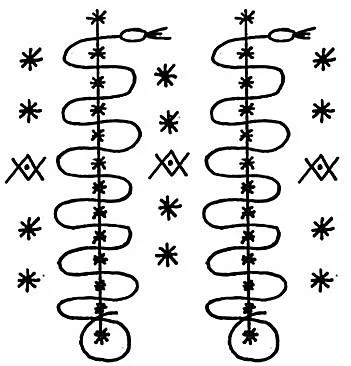
from here

from here
it's not 1 to 1, but it makes aesthetic sense, especially if you focus on Damballah (giant white snake, associated with water, only speaks in hisses). I say "aesthetic", because Damballah appears to be a unilaterally positive force in vodun, according to what little I've learned about him in an hour of googling. In pop culture, he's responsible for all the possession magic in Chucky (which is counter to his benevolent and detached portrayal in religion). all of this makes a strong but surface-level connection to Domori's snake, who I am comfortable categorising as non-benevolent and deeply concerned with human affairs.
(side note: my personal working theory is that the Witch is deliberately invoking and corrupting this symbol of a benevolent and powerful creator lwa who is deeply averse to impurity - sort of like inverting a Christian crucifix.)
Hello! Since you're taking research requests, I was wondering what you thought of the images that appear on screen when the Witch attacks you during the party. I don't know how many there are, exactly, but I know there's one that depicts a snake wrapped around a gem and another that looks like a broken baby doll. Do you think there's any deeper meaning to them, or are they there just to look creepy?
hi hi! thank you for the question! there are six images that can flash on the screen when attacked by the witch: a snake wrapped around a gem, a broken baby doll, a cornucopia full of skulls, an open mouth over a fire, two hands touching a fetus, and another strange image of what i assume to be a distorted baby with a symbol on it’s forehead.
the snake wrapped around the gem seems to be alluding to domori trapped in the gem/ice on the second floor. the image itself does not seem to be a symbol for anything specific, so this is where my speculation ends.
the broken baby doll might be referencing rei and her creepy counterpart since in the sintra residence route, she does have a doll that brian must collect for a puzzle. since the two baby dolls look completely different though, i think this is a bit of a stretch, and it might be there just to be creepy.
a cornucopia typically represents harvest and/or an abundance of something, so we can take the image of the cornucopia full of skulls to mean there is an abundance of death at sintracorp- not like we really needed a picture to let us know that...
the open mouth over the fire is directly referencing dormori’s burning at the stake. though the picture is of a campfire, most fire imagery and metaphors within yuppie psycho reference the burning, so i am assuming the same applies here.
in-game, hands with long black nails are typically used to reference the witch (such as in cutscene 09, bewitched) so i am going to assume the hands over the fetus belong to the witch. with this knowledge, i believe the fetus is meant to represent rei’s birth, since we are told that rei was only able to be conceived via domori’s blessing.
as for the last image... i am not entirely sure! i want to say it is also a baby doll and therefore relates to the other image of a baby doll, but it looks much more realistic than the other one. it also has a symbol drawn on it’s head, which i tried to look into to no avail. i am going to assume this is just to add to the creepiness factor of the other drawings and that it has no particular meaning. if anyone wants to try to identify the symbol on the baby, here is the image:

23 notes
·
View notes

